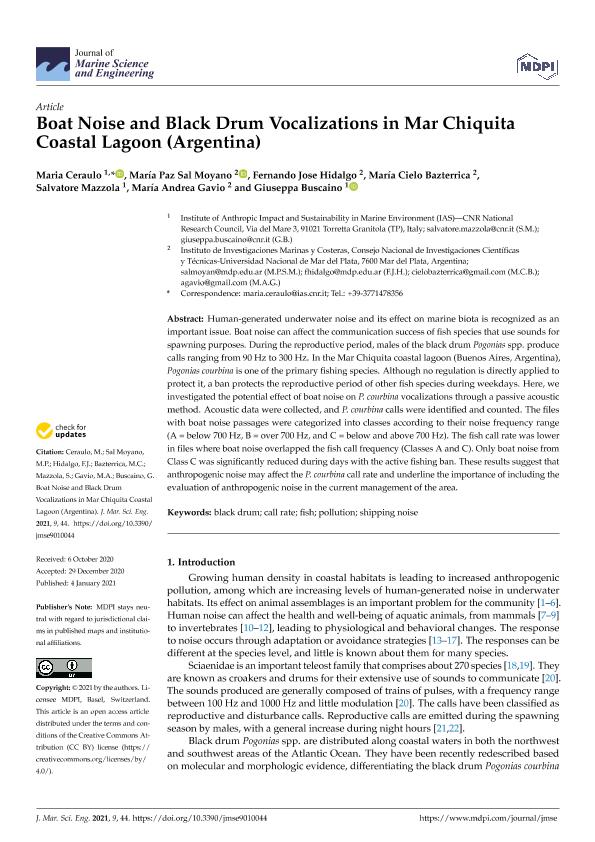Artículo
Boat noise and black drum vocalizations in Mar Chiquita coastal lagoon (Argentina)
Ceraulo, Maria; Sal Moyano, María Paz ; Hidalgo, Fernando Jose
; Hidalgo, Fernando Jose ; Bazterrica, Maria Cielo
; Bazterrica, Maria Cielo ; Mazzola, Salvatore; Gavio, Maria Andrea; Buscaino, Giuseppa
; Mazzola, Salvatore; Gavio, Maria Andrea; Buscaino, Giuseppa
 ; Hidalgo, Fernando Jose
; Hidalgo, Fernando Jose ; Bazterrica, Maria Cielo
; Bazterrica, Maria Cielo ; Mazzola, Salvatore; Gavio, Maria Andrea; Buscaino, Giuseppa
; Mazzola, Salvatore; Gavio, Maria Andrea; Buscaino, Giuseppa
Fecha de publicación:
01/2021
Editorial:
Multidisciplinary Digital Publishing Institute
Revista:
Journal of Marine Science and Engineering
ISSN:
2077-1312
Idioma:
Inglés
Tipo de recurso:
Artículo publicado
Clasificación temática:
Resumen
Human-generated underwater noise and its effect on marine biota is recognized as an important issue. Boat noise can affect the communication success of fish species that use sounds for spawning purposes. During the reproductive period, males of the black drum Pogonias spp. produce calls ranging from 90 Hz to 300 Hz. In the Mar Chiquita coastal lagoon (Buenos Aires, Argentina), Pogonias courbina is one of the primary fishing species. Although no regulation is directly applied to protect it, a ban protects the reproductive period of other fish species during weekdays. Here, we investigated the potential effect of boat noise on P. courbina vocalizations through a passive acoustic method. Acoustic data were collected, and P. courbina calls were identified and counted. The files with boat noise passages were categorized into classes according to their noise frequency range (A = below 700 Hz, B = over 700 Hz, and C = below and above 700 Hz). The fish call rate was lower in files where boat noise overlapped the fish call frequency (Classes A and C). Only boat noise from Class C was significantly reduced during days with the active fishing ban. These results suggest that anthropogenic noise may affect the P. courbina call rate and underline the importance of including the evaluation of anthropogenic noise in the current management of the area.
Palabras clave:
BLACK DRUM
,
CALL RATE
,
FISH
,
POLLUTION
,
SHIPPING NOISE
Archivos asociados
Licencia
Identificadores
Colecciones
Articulos(IIMYC)
Articulos de INSTITUTO DE INVESTIGACIONES MARINAS Y COSTERAS
Articulos de INSTITUTO DE INVESTIGACIONES MARINAS Y COSTERAS
Citación
Ceraulo, Maria; Sal Moyano, María Paz; Hidalgo, Fernando Jose; Bazterrica, Maria Cielo; Mazzola, Salvatore; et al.; Boat noise and black drum vocalizations in Mar Chiquita coastal lagoon (Argentina); Multidisciplinary Digital Publishing Institute; Journal of Marine Science and Engineering; 9; 1; 1-2021; 1-17
Compartir
Altmétricas



